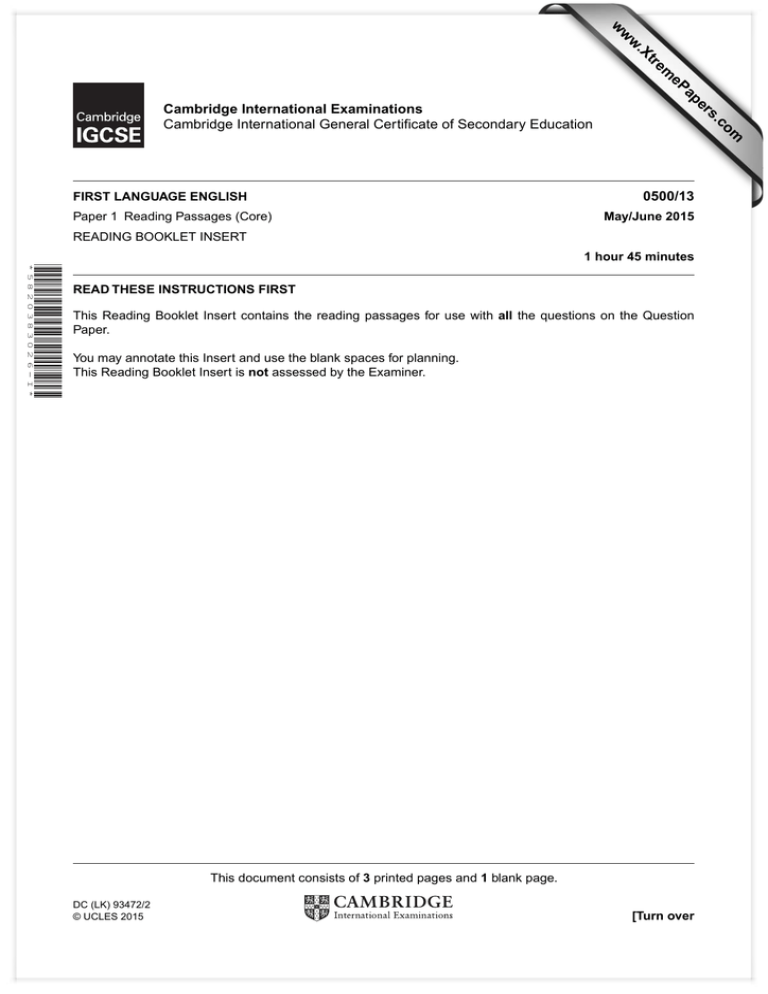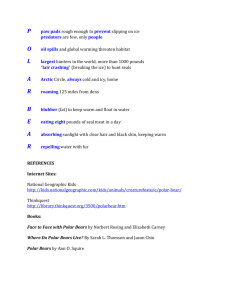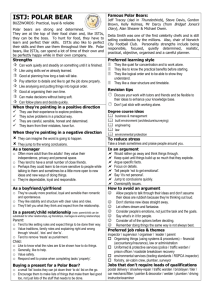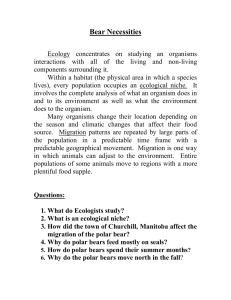www.XtremePapers.com Cambridge International Examinations 0500/13 Cambridge International General Certificate of Secondary Education
advertisement

w w om .c Paper 1 Reading Passages (Core) s er FIRST LANGUAGE ENGLISH ap eP m e tr .X w Cambridge International Examinations Cambridge International General Certificate of Secondary Education 0500/13 May/June 2015 READING BOOKLET INSERT 1 hour 45 minutes *5820383026-I* READ THESE INSTRUCTIONS FIRST This Reading Booklet Insert contains the reading passages for use with all the questions on the Question Paper. You may annotate this Insert and use the blank spaces for planning. This Reading Booklet Insert is not assessed by the Examiner. This document consists of 3 printed pages and 1 blank page. DC (LK) 93472/2 © UCLES 2015 [Turn over 2 Part 1 Read Passage A carefully, and then answer Questions 1 and 2 on the Question Paper. Passage A: Encounters With Ice Bears In the following passage the writer, Michelle Paver, describes her experience of meeting polar bears in a remote part of Canada. The Inuit name for the polar bear is Nanuq: the most feared and respected of all Arctic creatures. And no wonder. The polar bear is the largest land predator in the world, and an incredibly skilled hunter, equally at home on ice, a mountain, or in the sea. Unlike the grizzly or black bears, which usually leave people alone if they behave themselves, polar bears quite naturally regard a solitary human being as prey. As soon as I arrived at the town of Churchill in Canada, I put on my winter gear and went for a walk. I was warned not to go out into the scrubland beyond the town, in case I met a bear. It’s always best to heed local advice, especially when it concerns polar bears, so instead I headed towards the broad, snowy main street. I turned down a side-road, hoping to dip my hand in the waters of Hudson Bay. A large sign warned me back: POLAR BEAR ALERT – STOP! I decided to pay attention, and turned back. Even in town, I knew that I could get unlucky and meet a bear, and I often saw a small truck bearing the logo, ‘Polar Bear Patrol’ crawling through town, keeping a lookout 24 hours a day. I was told that if I did meet a bear, I should duck into the nearest house. In Churchill, nobody locks their doors. I learned, too, that the previous year, a curious bear had battered down the front door of a house, to see what was inside. Luckily, nobody was hurt. In Churchill, most householders keep a loaded gun close by, for the purpose of scaring off bears. Night fell: a beautiful, crisp Arctic night, glittering with stars. I really wanted to go for a solitary, moonlit walk, but I decided against it. This turned out to have been a good idea. A little later, a polar bear clambered on to the balcony of my guest-house, and had to be chased away with shots fired into the air. To get closer to polar bears without being eaten, I went out in what’s called a ‘tundra buggy’ – a large truck, but with an open-air viewing platform made of strong metal mesh stuck on to the back. This platform is a metre above the snow, so that polar bears can’t jump up and eat occupants. The first time we went out was at night, and the moon and headlights lit up the humped, snowy scrubland for kilometres around – but no bears. Then, as I stood on the open-air platform peering into the gloom, one of the ‘humps’ about ten metres away rose and ambled towards me. What struck me most about the bear was its silence. The enormous creature was walking across a crisp snow-crust and yet his huge paws made not a sound – my hiking boots would have crunched loudly with every step. In the days that followed, I watched bears by night: playing like giant children in the snow, or sleeping in the seaweed at the edge of the bay, and by day: sparring, lounging, eating ice to keep cool (it was only –8C, too warm for them!). Most memorably of all, on one freezing, snowy afternoon, a young male meandered under the grille of the platform on which I stood. I knelt down. He gazed up at me. For a few heart-stopping minutes, we locked gazes. I’ll never forget the look in those strangely innocent, dark eyes. © UCLES 2015 0500/13/INSERT/M/J/15 5 10 15 20 25 30 35 3 Part 2 Read Passage B carefully, and then answer Question 3 on the Question Paper. Passage B: Endangered Animals: Polar Bears The following passage is adapted from a website which raises awareness of endangered species and the importance of protecting them. Polar bears have heavy white fur on their bodies, which insulates them from the extreme cold. They are swift runners, and usually cover hundreds of kilometres. They are also expert swimmers. They are found throughout the arctic region, and are the first animal to be categorized as endangered because of global warming. Their life span is about 25 years. A polar bear’s diet generally consists of fish, seal, caribou, birds, seaweed, and grass. Sometimes they feed themselves on a whale, which has lost its way and come near to the shore. According to the International Union for Conservation of Nature (IUCN) and the Endangered Species Act (ESA), polar bears are threatened with extinction. Habitat loss of the polar bears due to climate change is the major cause of their being endangered. In addition to this, they are excessively hunted for their hides, which are priceless. It is believed that only 20,000–25,000 polar bears are alive in the wild. Extracting oil from below the Arctic Ocean also threatens the survival of polar bears. The process spreads toxic chemicals in the seawaters, and pollutes the surroundings. This makes it difficult for the endangered animals such as polar bears to hunt for their food. Moreover, unregulated sport hunting from aircraft is a further reason for polar bears becoming an endangered species. Polar bears are free roaming creatures, so they are difficult to protect. To check the decreasing numbers of polar bears, an international agreement was signed in 1973 which allows the use of only traditional weapons for the hunting of polar bears. The World Wildlife Federation (WWF) is a leader in the conservation of polar bears. It has started an adoption programme to save the endangered animals. In the past, damage caused to the environment by humans happened as a result of ignorance. But now that we are aware of its negative consequences, it is our responsibility to correct it. We have the capability to do this and a duty to make changes because we will be responsible for the world we leave to our children. © UCLES 2015 0500/13/INSERT/M/J/15 4 BLANK PAGE Permission to reproduce items where third-party owned material protected by copyright is included has been sought and cleared where possible. Every reasonable effort has been made by the publisher (UCLES) to trace copyright holders, but if any items requiring clearance have unwittingly been included, the publisher will be pleased to make amends at the earliest possible opportunity. To avoid the issue of disclosure of answer-related information to candidates, all copyright acknowledgements are reproduced online in the Cambridge International Examinations Copyright Acknowledgements Booklet. This is produced for each series of examinations and is freely available to download at www.cie.org.uk after the live examination series. Cambridge International Examinations is part of the Cambridge Assessment Group. Cambridge Assessment is the brand name of University of Cambridge Local Examinations Syndicate (UCLES), which is itself a department of the University of Cambridge. © UCLES 2015 0500/13/INSERT/M/J/15






